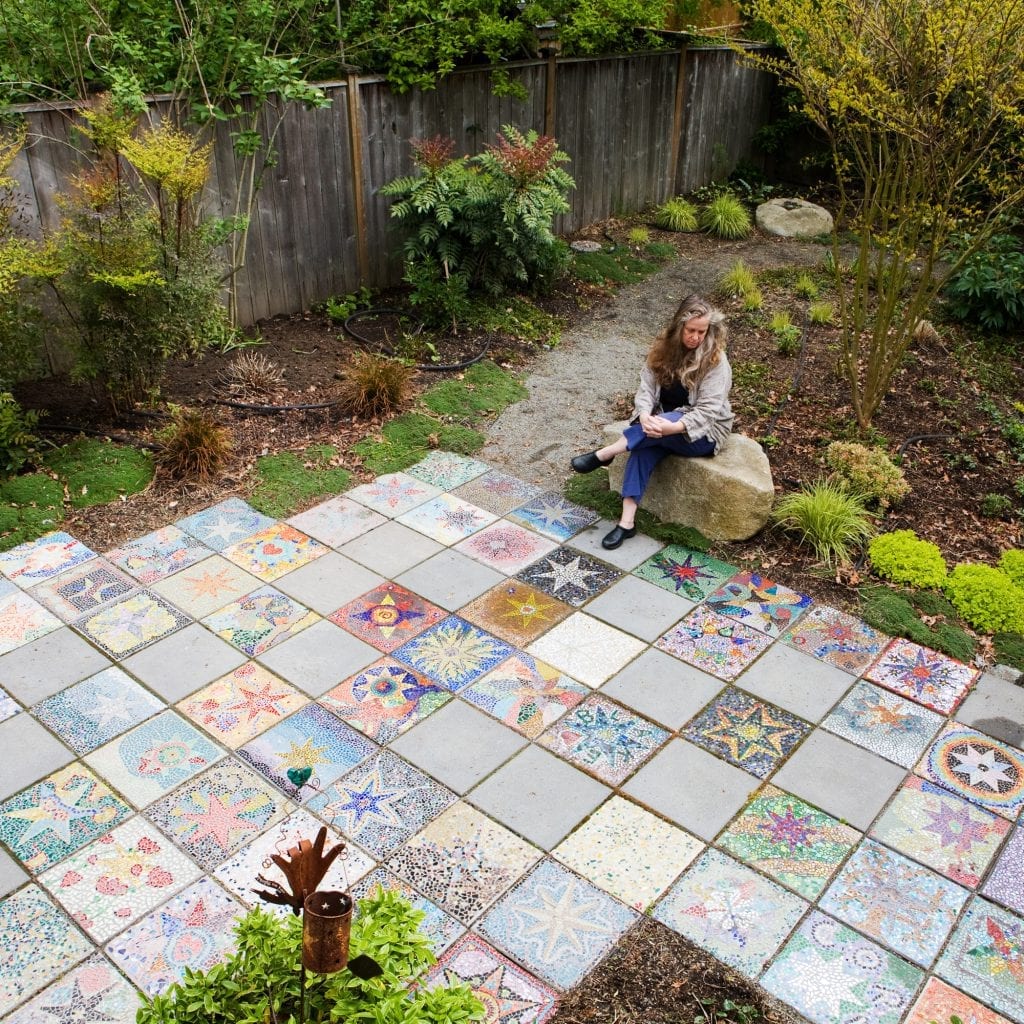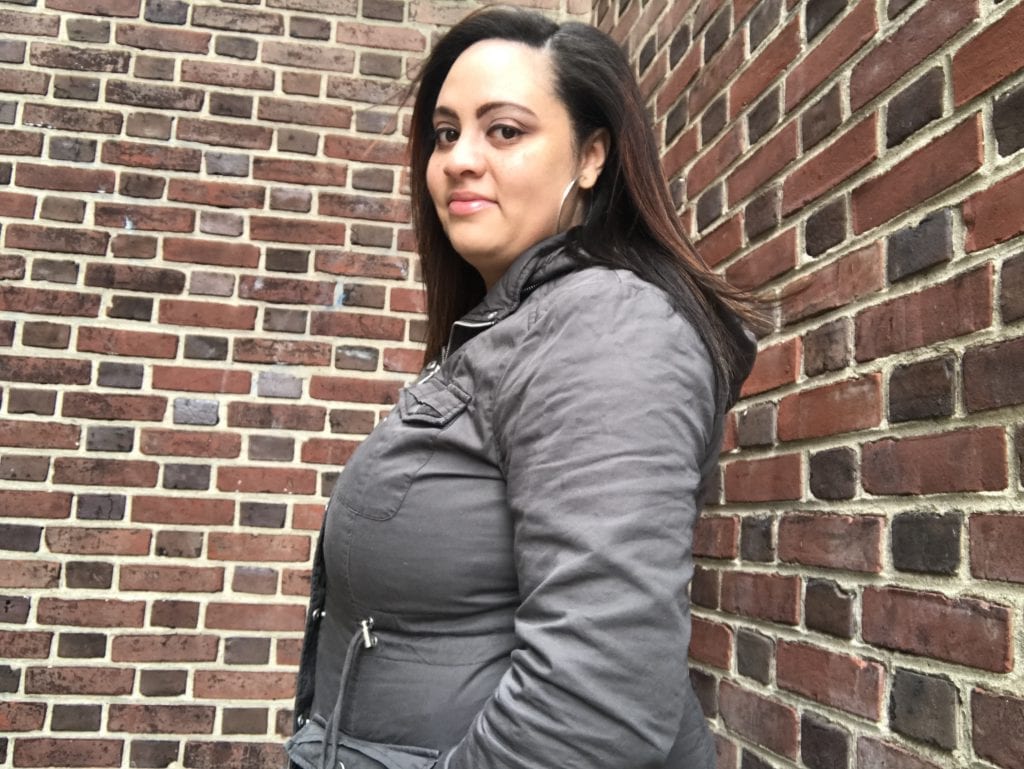Art Cafés have been focal gathering places for artists for centuries. A place where they could emerge from the isolation of their studios to exchange ideas, inspiration and find a connection between their creative process within the context of current events. For 2018, we have a selection of presenters that will share intimate stories connecting mosaic art with physical, emotional, spiritual and psychological health. Attendance will be open to all registered attendees for this series of intimate conversations.

Claire Barnett in her own memorial garden
Mosaics as Medicine with Claire Barnett
Wednesday, March 14, 2018, 6:00 pm
In this eye-opening presentation, Dr. Claire Barnett combines her 30 years of experience as a family physician with her 15+ years history of not only making mosaics herself but also offering mosaic making as medicine for hundreds of people. We all know intuitively that something special happens in our brain, in the calming “back” of our brain, as we piece together a mosaic. It is very different from the thinking, planning and imagining front part of our brain. The “front” brain comes up with the idea, understands the rules to follow, and makes thoughtful organized decisions. The “back” brain part of the experience is the soothing, almost non-thinking zone that we go into as we nip and place tesserae. There are neurobiological explanations for these feelings that we experience.
Claire will explain the basic neurobiology of this experience by consolidating and reviewing the current data on the roles the different parts of the brain play as we process information and creativity, especially in the face of trauma and grief. She will explain in easy to understand terms and images what functional MRI’s and other studies are revealing about how the brain responds to trauma. She will summarize the science behind what helpful things happen when we take pieces of tile or glass and put them in a row or fill in space, over and over again.
She will share her own personal discovery of this therapeutic power of mosaics as medicine which ultimately led her to open her own community-based studio, Seattle Mosaic Arts, where this unusual “medicine” is practiced. She will present “case histories” that provide moving and visual examples of this practice in action through the lives of people that have made mosaics with her over the years. She will share “best practices” that she has developed over the years to be most effective when working with people dealing with grief and trauma.
After listening to this presentation you will not only have a deeper understanding of why and how making mosaics may have been helpful in your own life but also come away with new tools for offering this unique medicine to others.
Instructor, mosaic artist and family physician Dr. Claire Barnett has been studying, creating and teaching mosaics for over 15 years. Claire began creating mosaics after the tragic death of her two young daughters in 2000. As her own backyard filled with memorial garden stones, Claire began expanding her studies, both in mosaic and in medicine, to incorporate the therapeutic nature of mosaics into her medical practice. In 2009 Claire opened Seattle Mosaic Arts. This community-based studio features workshops from international artists, mosaic technique classes, lectures, art shows, group events, commissions, and space and support for people to create their own mosaic projects. Claire specializes in therapeutic mosaics with a focus on grief and trauma. As well as teaching and lecturing extensively about mosaics she also has given talks for the medical community at Medical Associations conferences and Family Practice Residencies on the power of mosaics as medicine. Seattlemosaicarts.com

Meghan Walsh
Mosaic as Meditation with Meghan Walsh
Wednesday, March 14, 2018, 7:00 pm
“Clinical data and research show the health benefits of meditation including lowered stress, blood pressure, and even claims for anti-aging and reduction of dementia and Alzheimer’s diseases. The tradition of walking meditation is a form of meditation in motion. As a committed daily meditator in the Shambhala mindfulness tradition, and as a mosaic artist, the process of creating mosaic andamento is, for me, a poetic form of meditation in motion.
I was detailed to work at the White House in 2016 on issues related to building construction and disaster preparedness. With the responsibility and intensity of this work, I knew that both my meditation practice and my mosaic making time would be essential to both my sanity and to my effectiveness at the White House.” ~ Meghan Walsh
This presentation will focus on the process of creating mosaics, regardless of whether the final piece is an award-winner. It will touch on various methods of building a mosaic from pique assiette, opus palladianum (crazy paving) and more traditional andamento. It will bring special attention to the use of alternative and recycled materials that are traditionally not part of the mosaic lexicon that require an engagement with them that inherently helps one to heal parts of oneself. Brené Brown, the renowned author, and public speaker, best known for her TED Talks, works with the phenomenon of shame and vulnerability and encourages embracing imperfection. With each tessera we choose to adhere to our substrate, we can make the next “right” decision, do the next right thing to improve both the quality of our mosaic art we share with others and the quality of own our personal lives.
The shape of this presentation will include a visually based slide presentation of about 25 minutes, an audience participation exercise of 15 minutes, and a question and answer session of another 5 minutes. The intention of the presentation is to inspire and encourage audience members to see their work, and in particular, their process of making mosaics, as sacred and integral to their lives and health whether they are full-time artists or moonlighters. They will learn a bit about meditation in general and be encouraged to be courageous and brave in their own choices about materials, methods, and decisions in their work.
Meghan Walsh is licensed architect who works in the federal government by day and is a studio artist and residential design architect by night. She has served as a subject matter expert on energy-efficiency, healthy buildings and resilient design and construction at the White House. She has taught architecture at Catholic University, Howard University and the University of Michigan. She created a non-profit to take students to build creative urban infrastructure in Brazil, where she learned to speak Portuguese. She has lived and worked in the Czech Republic and South Africa. She holds a Bachelor of Fine Arts from University of Massachusetts, a Master’s of Architecture from the University of Michigan and a Master’s in Real Estate Finance from Georgetown University. She has also been teaching Pilates and Barre in DC for over 16 years. This past year she taught her first official mosaic course in the United Arab Emirates. She has been practicing Shambhala meditation since 2011 and is currently pursuing advanced coursework in the tradition. Meghanwalshmosaics.com

Meagan Corrado
Broken Glass, Creativity, and Healing: Mosaic as Therapy with Meagan Corrado
Wednesday, March 14, 2018, 8:00pm
Smalti meticulously chiseled by a hammer and hardie. Stained glass delicately shaped and cut. Ceramic tiles carefully broken and positioned. Tempered glass strategically layered on top of colorful inks. Broken pottery expertly arranged and integrated.
Mosaic includes a diverse array of materials, techniques, and processes. But one thing unites us as mosaic artists- our ability to take broken things and transform them into something whole. As mosaic artists, we are drawn to these broken materials. The broken pieces inspire us. They fuel our self-expression. They spark our inner drive to create.
This presentation will draw light to the therapeutic value of mosaic. The speaker will share her own personal experiences using mosaic as a way to heal from her own trauma. Additionally, she will talk about her experiences as a trauma therapist and the creator of the Storiez Trauma Narrative intervention as she used the “philosophy of mosaic” (taking broken pieces and transforming them into something whole) in her work. Finally, she will support the audience in reflecting on how they can use their own personal experiences to inspire and inform their own creative process.
Multimedia content including photographs and video will be used in the presentation. Audience members will also receive a simple activity to take with them. This activity will support them in reflecting on ways that they can benefit from the therapeutic value of mosaic in their personal, professional, and artistic lives.
Meagan Corrado is a Doctor of Social Work and a Licensed Clinical Social Worker. She earned her Doctorate of Social Work from the University of Pennsylvania in 2016 and her Masters of Social Services from Bryn Mawr College in 2009. She is a trauma therapist who integrates the arts into her practice with inner-city children and adolescents. She created the Storiez Trauma Narrative intervention, which supports trauma survivors in creating, voicing, and honoring their stories through a variety of creative mediums. Dr. Corrado currently serves as the President of the Mosaic Society of Philadelphia. She has been creating her own mixed media mosaics since 2012. Her current mosaic style involves building layers of alcohol ink, painted papers, personal writing, found objects, and tempered glass. Storiezguide.com

